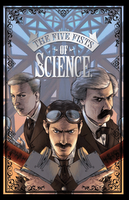 I was able to pick up The Five Fists of Science by Matt Fraction and Steven Sanders a week ago and just got a chance to read it. The basic plot is that Nikola Tesla comes up with a giant robot, which his friend Mark Twain decides is an ideal way to end war. In the process, though, they run afoul of some masters of the dark arts: J.P. Morgan, Andrew Carnegi and Thomas Edison. It has something of a League of Extraordinary Gentlemen feel about it, except that characters here are based (loosely) on real people instead of fictional ones.
I was able to pick up The Five Fists of Science by Matt Fraction and Steven Sanders a week ago and just got a chance to read it. The basic plot is that Nikola Tesla comes up with a giant robot, which his friend Mark Twain decides is an ideal way to end war. In the process, though, they run afoul of some masters of the dark arts: J.P. Morgan, Andrew Carnegi and Thomas Edison. It has something of a League of Extraordinary Gentlemen feel about it, except that characters here are based (loosely) on real people instead of fictional ones.Overall, I enjoyed the book. Although there are some obvious analogies to League, they're fairly superficial, I think. For one, League is designed more as an action-adventure series and the characters were chosen, in part, because they are no longer known entities in American popular culture. (This is most evident in Allan Quatermain's name being consistently mis-pronounced in the movie. I think it's also why producers insisted Tom Sawyer was to be included in the film.) With Fists there are more known quantities: Twain and Edison, certainly, and to a lesser degree Tesla, Morgan, Carnegi and Guglielmo Marconi. (Indeed, Tesla has received something of a resurgance in notarity in recent years thanks to films like The Prestige and TV shows like MythBusters.)
On another level, since League deals with fictional characters, their personalities are more mutable. There's a decidedly finite amount of work written about, for example, Mina Harker so writer Alan Moore had some freedom to reinterpret how she might act. Fraction, though, is dealing with people who's lives were under the spotlight for most of their adult lives and we know quite a lot more about. While there are some liberties taken -- I believe he used the phrase "gross character assination" with regards to Carnegi -- the protagonists at least have some reasonable basis in historical fact. While that might seem limiting, I should think it would provide greater freedom to develop character moments.
I've seen allusions to the story being in the steampunk genre, which I suppose it technically is. But that's really not the focus. The interest isn't so much in the fact that Tesla created this giant robot, it's in how Twain and others react to it. The character interactions are much more interesting, I think, and take up a larger portion of the book. What kind of man would go Yeti hunting? How would Twain talk with government officials when he was trying to sell an entirely new concept? Could Twain really manipulate crowd reactions that easily, and that blatantly? How would a man like Tesla try to apologize for a social faux pas? Those are the bits that stand out more prominently for me.
There's a style of pitching comic books that starts off: WHAT THE STORY'S ABOUT. The author then proceeds to outline the basic plot structure. That's where this steampunk element comes from. The next part of the pitch is then: WHAT THE STORY'S REALLY ABOUT. That describes the emotional connection that readers will get out of it. That's where I enjoyed this book -- the character interactions and their reactions to circumstances around them.
(For the record, the next section of the pitch is WHAT THE STORY'S REALLY, REALLY ABOUT, which gets into the fundamental themes that are addressed.)
All in all, I found it an enjoyable read and it's got my interest piqued in other vaguely historical fiction. I recently learned of a 2000 AD storyline called "Necronauts" that sounds interesting, as well...






0 comments:
Post a Comment